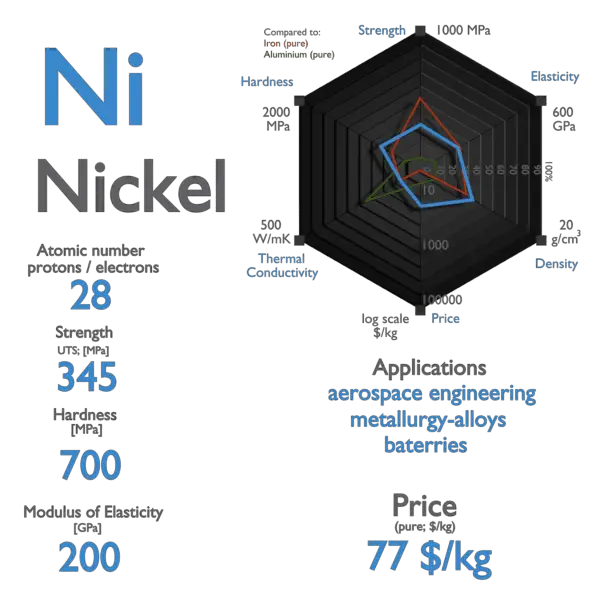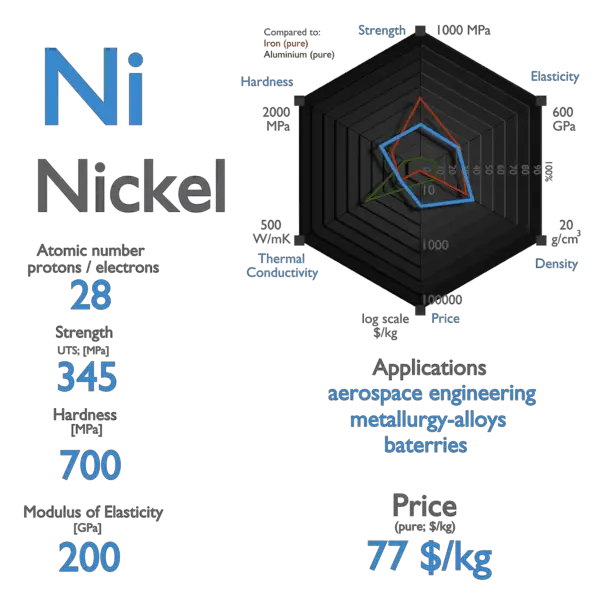Nickel, a versatile and valuable metal, plays a crucial role in numerous industries due to its unique combination of properties. From its discovery by Axel Fredrik Cronstedt in 1751 to its current applications, nickel has established itself as an essential element in various fields. In this post, we will delve into the properties, history, and diverse applications of nickel, shedding light on its significance in today’s world.
Properties of Nickel
Nickel possesses several notable properties that contribute to its wide range of applications.

Corrosion Resistance
Nickel exhibits excellent resistance to corrosion, making it highly desirable for use in environments where durability and long-term stability are essential. This property has led to its widespread use in industries such as construction, marine, and chemical processing.
High Melting Point
With a melting point of 1,455°C (2,651°F), nickel can withstand extreme temperatures. This characteristic makes it valuable in high-temperature applications, including aerospace, power generation, and industrial processes.
Mechanical Strength
Nickel is known for its exceptional mechanical strength, enabling it to withstand stress, pressure, and wear. This property is particularly advantageous in applications that require robust materials, such as automotive parts, machinery components, and structural elements.
Electrical and Thermal Conductivity: Nickel exhibits good electrical conductivity, allowing it to efficiently transport electrical currents. Moreover, it has substantial thermal conductivity, enabling the efficient transfer of heat. These properties make nickel indispensable in electrical and electronic devices, including batteries, wires, connectors, and heating elements.

History and Discovery
Nickel’s discovery can be traced back to 1751 when Axel Fredrik Cronstedt isolated the metal from a copper ore that deceived miners, earning the name “kupfernickel” or “false copper.” The isolation of nickel marked a significant milestone in the field of chemistry and set the stage for its subsequent applications.
Applications of Nickel
Stainless Steel Production: One of the most prominent uses of nickel is in the production of stainless steel. By incorporating nickel into steel alloys, manufacturers achieve enhanced corrosion resistance, strength, and heat resistance. Stainless steel finds applications in construction, transportation, kitchenware, and medical equipment.
Electrical and Electronics Industry
Nickel’s excellent electrical conductivity and magnetic properties make it indispensable in the electrical and electronics sector. It is used in batteries, electrical contacts, wires, and components for telecommunications, consumer electronics, and renewable energy systems.
Chemical Industry
Nickel catalysts play a vital role in a wide range of chemical reactions, facilitating processes such as hydrogenation, petroleum refining, and ammonia production. These catalysts enable efficient and selective chemical transformations.
Coinage
Nickel is commonly used in the production of coins, particularly in alloys known as cupronickel. Its durability, resistance to wear, and attractive appearance make it a popular choice for coinage worldwide.
Aerospace and Defense
Nickel-based superalloys exhibit exceptional heat resistance and mechanical strength, making them ideal for demanding applications in the aerospace and defense industries. Jet engines, gas turbines, and other high-performance components benefit from the superior properties of nickel-based alloys.
Nickel, with its remarkable properties and rich history, has established itself as a vital metal in various sectors. Its corrosion resistance, high melting point, mechanical strength, and conductivity make it an indispensable element in applications ranging from stainless steel production to aerospace engineering. Understanding the diverse uses and properties of nickel sheds light on its significance in modern industries and showcases its potential for future advancements.






qiyynw
wckdic